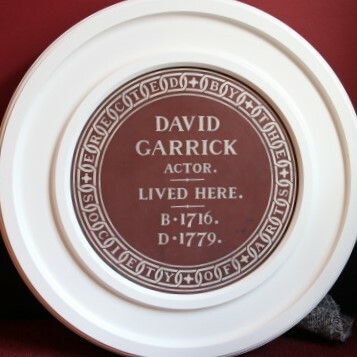Erection date: 1876
David Garrick, actor, lived here. B: 1716. D: 1779.
{Almost hidden in the decorative border:}
Erected by the Society of Arts
Garrick died in this house.
Erected April-May 1876.
Site: Garrick plaque - gone (1 memorial)
WC2, Adelphi Terrace, 5
Steve Roffey learnt about this lost plaque on one of the Blue Plaque walks that English Heritage arranged for the 150th Anniversary, this one conducted by Cathy Power in Hampstead on 8 May 2016. We thank Steve for passing the information on to us.
This plaque was placed at Garrick’s home in Adelphi Terrace in 1876 and removed when that was demolished in 1936. In 2016 it was by Wolley & Wallis in the Salisbury saleroom on behalf of Leslie Goodey OBE. The plaque was bought by the Garrick Club who now have it on display above the reception desk to the right of the entrance at their building in Garrick Street (opposite Floral Street). Steve tells us that it can just be seen from the street. The club have a library and an art collection and a very classy-looking on-line catalogue, with an , from which our image comes.
At we learn that the properties were numbered right to left and that Garrick's home (number 5) was in the middle of the Terrace.
We've learnt that it was common (probably still is) for photographs to be taken of a building when it is slated for demolition, so, always wanting to see a plaque in situ, we went looking for a photo. And we found an image at : "1936: ADELPHI TERRACE before it goes". That site has a zoom function and we captured the zoomed image of the central section of the terrace. Look closely and in the middle, on the ground floor, you can see what we believe is the plaque. There's a whitish patch surrounding a dark oblong, This is a much-polished brass name-plate of the Savage Club which was in nos 6-7, 1890-1936. On the next house to the right, a few feet higher than the name-plate, that's the Garrick plaque. And on the next house along, at the same height, can be seen the Adams' plaque at no. 4 which was lost when the terrace was demolished. Our page for the Adams plaque has a close-up.
All the houses in the Terrace were decorated inside in the distinctive ‘Adam style’, but no 5, the central house, was particularly fine. The ceiling of the front drawing-room was rescued from the demolition and is now on display in the British Galleries at the V&A Museum.










Comments are provided by Facebook, please ensure you are signed in to see them